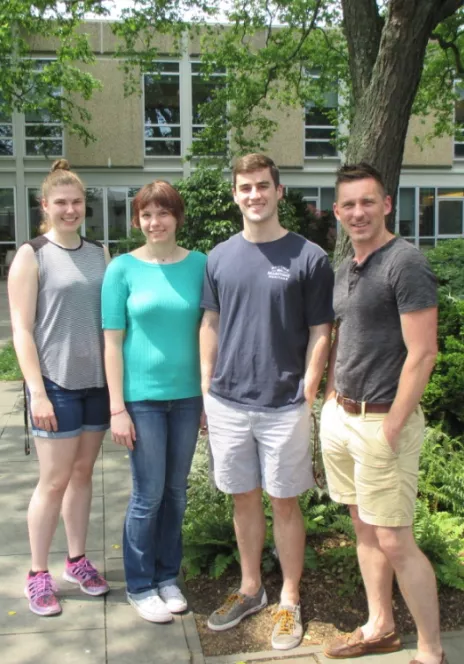Synthetic Chemist Chris Graves Receives NSF Research Grant

This summer's Graves Research Group (from left): Audra Woodside ’19, Mackinsey Smith ‘19, Henry Wilson ’18, and Chris Graves. Not pictured: Rares Mosneanu ’18.
Synthetic chemist Chris Graves recently received a coveted research grant from the National Science Foundation (NSF) that will build upon his and the College’s emphasis on sustainability and interdisciplinary learning.
Graves, an associate professor of chemistry and biochemistry, says he was thrilled to receive word of the grant, which supports his program on the preparation of aluminum complexes.
“You really pour your heart and soul into writing proposals,” he says, “so it’s a great feeling when your work is reviewed and judged and your peers have decided the work is relevant and important enough to fund.”
The grant was awarded as a Sustainable Chemistry, Engineering, and Materials (SusChEM) Funding Opportunity, through the NSF’s Chemical Synthesis Program. It will help cover the cost of project materials and supplies as well as a team of student researchers this summer.
“It will allow me to support multiple students and have a very strong research program for the next few years,” Graves says, adding that it will also help to cover his and his students’ travel to national and international conferences next year.
“I strongly believe in taking the students who work in my group to conferences,” he says, “so I’m happy to be able to help support them in this way.”
The grant supports Graves’ focus on preparing aluminum compounds that can accept or give off electrons. The ability to shuttle electrons is fundamentally important to many reactions that can make or break chemical bonds, Graves says, aligning with his interest as a synthetic chemist.
The issue, Graves says, is that aluminum typically cannot shuttle electrons in this way; precious metals like platinum and palladium are used instead. But these metals are more costly, scarce, and toxic than aluminum. Hence, opportunity.
“If we can prepare aluminum complexes that can effectively shuttle electrons,” Graves says, “we can open up new possibilities for the application of this environmentally friendly metal and limit the utilization of precious metals.”
Joining that effort this summer is the Graves Research Group: Rares Mosneanu ’18, an Honors neuroscience special major from Romania; Mackinsey Smith ‘19, a chemistry and mathematics major from Austin, Tex.; Audra Woodside ’19, a chemistry and religion major from Woodstown, N.J.; and Henry Wilson ’18, a chemistry major from Jacksonville, Fla.
Woodside joined the lab in hopes of learning more about inorganic chemistry and in a research environment and is relishing the experience.
"Chris has been a fantastic mentor," she says. "His dedication and obvious passion for chemistry shines through in even the smallest aspects of the lab."
Adds Smith: "As a student considering graduate school, working in the Graves lab has been incredibly valuable, as it has given me the opportunity to gain research experience and see what working in a research lab is like."
Graves works directly with two to four students throughout the academic year and summer and considers them “vital” to his program. He and his group explore the intersections of inorganic, organic, and green chemistries in a recently renovated lab space equipped with two gloveboxes, three hoods, two Schlenk lines, a solvent system, a potentiostat, “and lots of fun glassware and equipment,” Graves says. “A perfect setup to make some inorganic molecules!”
Graves holds a joint appointment with the Chemistry and Biochemistry Department and the Environmental Studies Program. Blending these disciplines gives him an advantage in how he thinks about sustainable chemistry, he says, exposing him to ideas and concepts he would not have encountered in a traditional chemistry curriculum — and building soft skills.
“It has also allowed me to interact with a broad range of students on campus and to discuss my research program with non-specialists across the College,” Graves says. “I think this is forcing me to become a better communicator.”
Swarthmore is investing in its vibrant intellectual culture. Learn how at lifechanging.swarthmore.edu.



